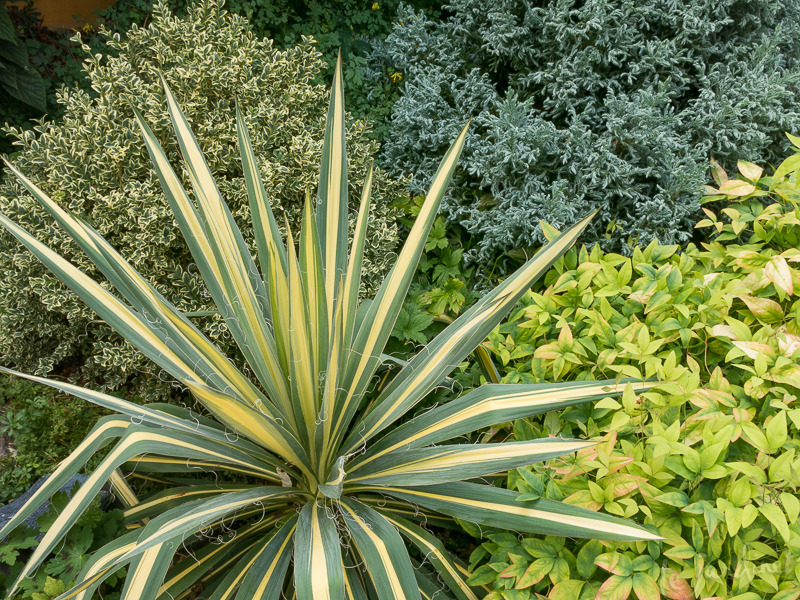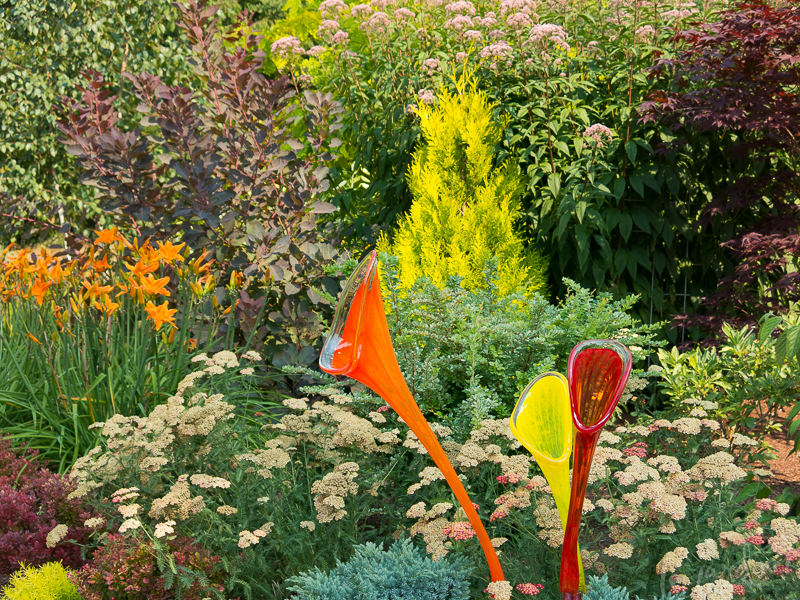Color-Changing Evergreens

Funnily enough, no-one has ever asked me to design a high maintenance garden, yet there is a common misconception that low maintenance translates to an endless row of boxwood or a border entirely devoted to rhododendrons. While these may be easy care they certainly won’t win any design awards. Yet evergreen trees and shrubs are an important part of low maintenance design since they reduce the time spent raking up leaves in fall. The trick, however, is to select several such plants that change color in some way during the year to offer dynamic seasonal interest and there are a number of both broadleaf and conifers that fill that role with style
Broadleaf evergreens
Broadleaf evergreens are those plants which have broad surface areas (as opposed to needles) and keep their leaves year round e.g. camellia. Many broadleaf evergreens do provide year round interest by virtue of their flower or fruit production and so earn their place in the garden. But there are several candidates which also change color, a feature I like to look for when designing landscapes or easy care, eye-catching container gardens.
Heavenly bamboo (Nandina domestica) is popular here in the Pacific Northwest but be aware that this plant is invasive in some parts of the United States so check with a local horticultural professional before planting. Typically the fern-like, soft leaves are in shades of green, chartreuse, burgundy and purple, deepening to rich red in winter, especially if planted in full sun. Older varieties and the species also have clusters of white spring time flowers followed by bright red berries in fall. Thanks to their drought tolerance (once established) and fabulous adaptability for cut flower arrangements these really do earn a 5 star rating in my design book. I personally prefer the newer, mounding varieties such as Gulf Stream and Obsession which offer little in the way of flowers or berries (which also reduces their invasive tendencies). The new First Editions variety Cool Glow Pomegranate looks exciting too – I need to try that one!
I have valued Kaleidoscope abelia (Abelia x grandiflora 'Kaleidoscope') for its bright variegated foliage for many years and it’s a popular addition to my evergreen container and landscape combinations, enjoying the hummingbird attracting tubular white flowers and orange tints to the foliage in fall. However, I also grow several of the larger, non-variegated glossy abelia and I must say I am enjoying these in my garden even more. This is reliably deer resistant, drought tolerant, and its glossy, deep green leaves turn a rich shade of mahogany with bright red highlights as the temperatures drop. Tubular white flowers adorn these bushes for many months and are highly visible against the dark leaves. This quiet beauty provides an understated foil for showier winter specimens such as nearby golden Skylands spruce (Picea orientalis 'Skylands') and Louie pine (Pinus strobus 'Louie')

Rainbow leucothoe is a true chameleon; these summer shades of green and cream are transformed into deep burgundy in winter
For bullet proof color in the shade garden I look to drooping fetterbush (Leucothoe spp) , especially the varieties Scarletta and Rainbow whose foliage becomes increasingly red as winter progresses. These elliptical leathery leaves make good companions to the more delicate evergreen ferns such as autumn fern (Dryopteris erythrosora) which also changes color during the growing season, soft mosses and wispy grasses such as the bronze toned leatherleaf sedge Red Rooster (Carex buchananii ‘Red Rooster’). This arching shrub looks perfectly at home in the woodland garden but will cope with some sun if the soil is well amended with compost to retain moisture. This is a favorite of mine for fall/winter container gardens as well as maintenance challenged gardeners! Fragrant bell shaped flowers adorn the plants in spring as a delightful bonus as is its deer resistance.

Celebrate the colder months with Rainbow drooping fetterbush, Bressingham Ruby elephant ears and hardy cyclamen
When a plant has the choice of common names pigsqeak or elephant ears you have to wonder if it wouldn’t prefer to be known by its botanical name Bergenia! I’m not sure where the name pigsqueak came from, but at least elephant ears aptly describes the shape of the fleshy leaves on this easy care perennial. These thrive in partial shade with reasonable moisture and display thick spikes of white or pink flowers in spring. Equally striking, however, is the color change the foliage undergoes in the colder months especially the varieties Bressingham Ruby and the more compact Winter Glow. In both cases the green leaves turn burgundy in winter. Try planting these in combination with white flowering spring bulbs such as drifts of snowdrops to create a vivid early season vignette and a white variegated form of andromeda (Pieris japonica) such as Flaming Silver or the smaller Little Heath for long term interest. Note that the andromeda itself also changes color, the foliage taking on a rosy hue in winter and new growth typically a striking pink-red.
Conifers
It is only in the past 20 or so years that I have gained a better appreciation for conifers in the garden. Thankfully, long gone are the days when we were limited to choosing between a monster juniper that threatened to swallow the entire garden or a pine tree which towered over the house. Today we are tempted by beauties in shades of green, blue and gold from the petite to the giant. Still not enough choice for you? Well there are many fabulous conifers which even change color during the winter, some of which actually look their best in colder months!
The dwarf mugo pine Winter Gold (Pinus mugo 'Winter Gold') is one that conifer expert Adrian Bloom expounds the beauty of this in his book ‘Gardening with Conifers’. The long, dark green summer needles transition to golden hues in late autumn. Chief Joseph would be a wonderful alternative albeit with a different habit. What a perfect contrast to black mondo grass or another great winter conifer; Siberian cypress (Microbiota decussata). The prostrate form and lacy texture of this Siberian cypress contrasts well with the fluffy pine but the winter color combination is exceptionally striking as the Siberian cypress turns dusky purple just as the pine reaches its golden peak. This tough conifer just asks for full sun and good drainage. Its mature size is just 12-18” wide and 10-16’ wide but can be trimmed for size. Too big? Check out the new, more compact variety Celtic Pride from Proven Winners – I'm trialing this in my garden right now and have been very impressed so far.

The flowers on Crimson Velvet barberry echo the warm tones of Rheingold arborvitae. Plum Pudding heuchera completes the scene. Design by Daniel Mount
Some conifers have a rather muddy color change in winter in my opinion, such as the popular slender Hinoki cypress (Chamaecyparis obtusa 'Gracilis'). Yet once again these can serve to highlight brighter companions such as Rheingold arborvitae (Thuja occidentalis ‘Rheingold’). This turns a distinctive orange shade in winter, returning to summer chartreuse/ bright green.
Blue surprise Port Orford cedar (Chamaecyparis lawsoniana ‘Blue surprise’) is a favorite conifer of mine for both landscape and container design. Its bright steel blue, finely textured foliage is gorgeous enough. The tight columnar form makes it suitable for narrow spaces while its mature height of 10’ earns it a place as a vertical focal point in most designs. The grafted variety in the Guardian Series by Monrovia offers disease resistance – a significant improvement. However, this beauty has yet another attribute – it gains a gorgeous burgundy cast in winter. Plant this in full sun where you can enjoy it year round and you won’t be disappointed.

Trumpets of glass echo the colors of the surrounding plants. The summer border includes Forever Goldie arborvitae, Flasher daylily and Fireglow Japanese maple. Design by Le jardinet
In my own garden I also have golden Japanese cedar (Cryptomeria japonica 'Sekkan-sugi') and several Forever Goldie golden arborvitae (Thuja plicata 'Forever Goldie') all of which stand out like beacons in the winter landscape.
More inspiration

Bellevue Botanical Garden, WA is filled with so many wonderful ideas. This vignette is included in my book Gardening with Foliage First (Timber Press)
Visit your local public and botanical gardens to get ideas for winter vignettes. I have also co-authored two popular books on foliage that include combination ideas using many of the plants mentioned above. You can get details of all my books here.
Finally, check out my popular online course Secrets to Selecting Low Maintenance Plants. You'll learn how to identify the trouble makers, how to combine plants effectively, make strategic choices and design with confidence.
Remember, evergreen doesn’t have to mean always green – or boring.
Updated from my original 2012 post
Contains some affiliate links
Subscribe to Receive Blog Posts
Gardening inspiration delivered right to your inbox from Le Jardinet



Karen-your combinations and selections are exquisite. I too am a huge fan of incorporating evergreens in the landscape for all season interest. Many of the broad-leaved evergreens you have mentioned here on on my favorites list. I love your comment at the end that evergreens don’t always have to be green…so true!
Hi Lee, lovely to see your name pop up! Hope you're keeping well – thanks for stopping by.
Hi Karen,
I adore your blog!!! Your garden ideas are terrific and the plant choices delicious! I was wondering if you might consider writing about rabbits as well as your favorite choices for extra small trees. Rabbits are doing terrible damage to gardens here in Seattle due minimal natural predators. And…with our small urban yards we need to plant small trees so we can enjoy them to maturity and beyond without the fear of removal.
We have met in the past and I hope to run into you sometime in the future!
Best,
Megan Smith
hi Megan, thanks for your lovely comment. I've been asked so many times to write a book on rabbit-resistant design. I fear it would be a very short book! In my garden they eat everything from crocuses and snowdrops to barberries and heathers.
Good idea for a feature on small trees. I do have a very popular blog post on small trees for skinny conifers which focuses more on slender varieties than short but it might be a start for you: https://lejardinetdesigns.com/2013/02/11/skinny-conifers-for-tight-spaces/. There's a link to a free download at the end too. Check that out!